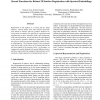Free Online Productivity Tools
i2Speak
i2Symbol
i2OCR
iTex2Img
iWeb2Print
iWeb2Shot
i2Type
iPdf2Split
iPdf2Merge
i2Bopomofo
i2Arabic
i2Style
i2Image
i2PDF
iLatex2Rtf
Sci2ools
140
Voted
ICPR
2008
IEEE
2008
IEEE
Kernel functions for robust 3D surface registration with spectral embeddings
Registration of 3D surfaces is a critical step for shape analysis. Recent studies show that spectral representations based on intrinsic pairwise geodesic distances between points on surfaces are effective for registration and alignment due to their invariance under rigid transformations and articulations. Kernel functions are often applied to the pairwise geodesic distances to make the registration process based on spectral embedding robust to elastic deformations. The Gaussian kernel is most commonly used, but the effect of the choice of the kernel function has not been studied in the previous works. In this paper, we compare the results obtained with several different choices and show empirically that significant improvements can be achieved in shape registration with appropriate choices.
Computer Vision | ICPR 2008 | Kernel Function | Pairwise Geodesic Distances | Spectral Embedding Robust |
| Added | 30 May 2010 |
| Updated | 30 May 2010 |
| Type | Conference |
| Year | 2008 |
| Where | ICPR |
| Authors | Xiuwen Liu, Arturo Donate, Matthew Jemison, Washington Mio |
Comments (0)

